Puerto Rico, a stunning Caribbean island, isn’t only renowned for its scenic beaches, lively culture, and delectable cuisine but also for its rich array of marine life. Among the captivating marine diversity is the existence of sharks in the surrounding waters. While these creatures are frequently misunderstood and feared, they hold a vital position in upholding the balance and health of the marine ecosystem.
Today, we’ll dive into the diverse shark species gracing Puerto Rico’s shores, their interactions in the region, and the spots where you might be able to catch a glimpse of them!
1. Whale Shark

The biggest fish in the world, the whale shark can occasionally be spotted in Puerto Rico!
©Aaronejbull87/Shutterstock.com
The whale shark holds the title of being the world’s biggest shark species and is occasionally seen in the waters surrounding Puerto Rico. Contrary to what its name suggests, it’s neither a whale nor a threat to people—this is true for most sharks, in fact.
Unique among sharks, their mouths are situated right at the front of their heads instead of the more typical placement on the underside. Their heads are broad and flat, with a rounded snout. They also have tiny eyes, five large openings for breathing, and they sport two fins on their back as well as two on their sides.
The record for the longest verified whale shark is an astonishing 61.7 feet, although most are usually found to be between 18 and 32 feet long.
These massive creatures are comfortable in a variety of water depths, from the open ocean to more confined coastal areas, as well as the sheltered waters around coral islands and underwater ridges. Despite their intimidating size, they feed by filtering small organisms like plankton, miniature shellfish, and groups of small fish through their wide mouths.
As the third largest marine animal—surpassed only by blue whales and fin whales—whale sharks are remarkably gentle giants. They pose absolutely no risk to humans. In fact, researchers and underwater explorers often swim alongside them without any concern for their safety.
2. Antilles Catshark
The Antilles catshark is found in a few locations, including the waterways near Florida, Jamaica, and Puerto Rico. This species has horizontally-shaped oval eyes equipped with protective membranes, followed by small breathing holes known as spiracles. Its mouth extends into long grooves at each corner, and it boasts an impressive 56 teeth in the upper jaw and 52 in the lower jaw. They also have five sets of openings for breathing, known as gill slits.
These sharks aren’t particularly big, reaching a maximum length of just 18 inches. Their habitat is restricted to the western central part of the Atlantic Ocean. Their diet mainly consists of shrimp, and they are believed to form groups when searching for meals.
Known for being harmless to people, there are no reports of unprovoked attacks by this species. They are often described as one of the cutest shark species found in the waters of Puerto Rico.
3. Silky Shark
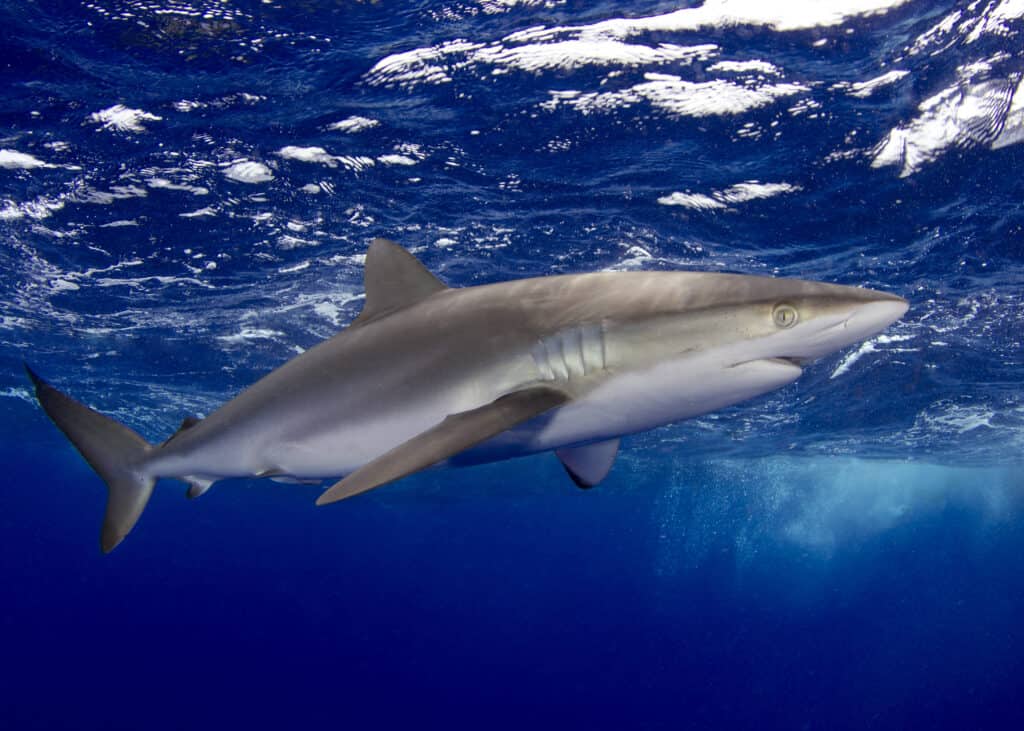
A relatively large shark, the silky shark can be found in Puerto Rico.
©Matt9122/Shutterstock.com
Silky sharks are frequently spotted in the waters surrounding Puerto Rico. These are sizable yet slim sharks with elongated, flattened snouts, big eyes, and finely jagged teeth. Their second back fin is positioned low on their bodies and extends into a lengthy trailing edge. They are a gray or blue-gray color on their upper side and are white underneath.
Silky sharks are relatively large, often reaching lengths of about 8 to 10 feet, with some exceptional individuals stretching to 11 feet. Their distinctive trait lies in their extensive wanderlust, populating warm waters that stretch from Massachusetts in the U.S. all the way down to the southern reaches of Brazil, encompassing the Caribbean Sea and the Gulf of Mexico.
In terms of diet, they predominantly indulge in a variety of fish and squid, occasionally adding shellfish to their menu.
While they’re commonly spotted, exercising caution around silky sharks is recommended. They’ve earned a reputation for their aggressive nature, with their size amplifying the potential for risk. An interesting behavior they exhibit is arching their backs, lifting their heads, and lowering their tails, which is believed to be a display of warning.
4. Nurse Shark
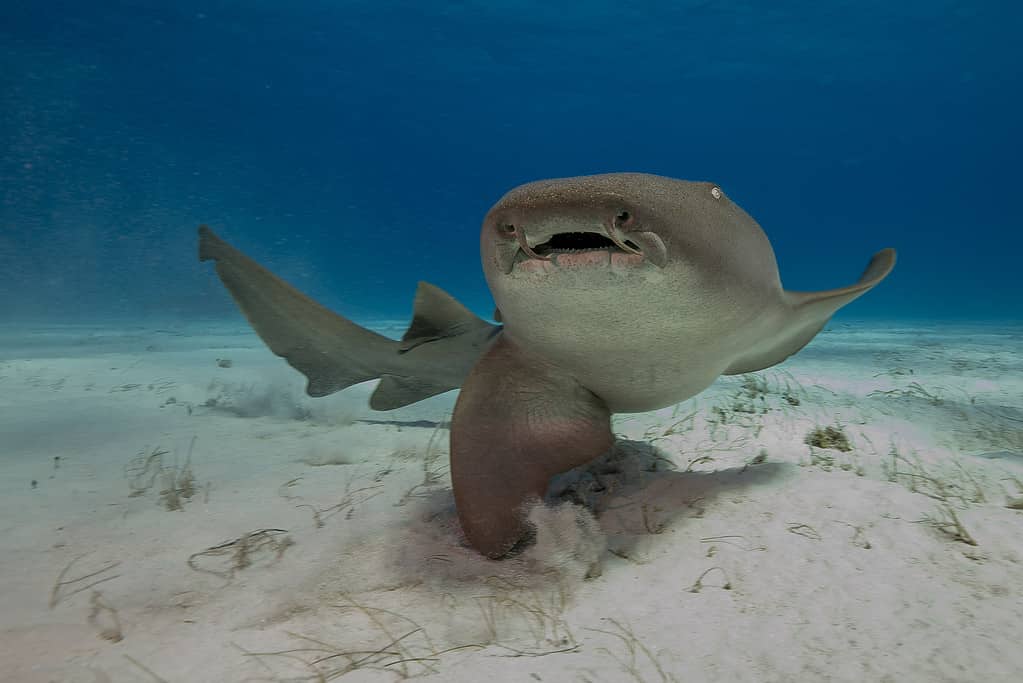
Nurse sharks
are generally non-threatening.
©Stevelaycock21 / CC BY-SA 4.0 – License
In Puerto Rico, you’re likely to encounter nurse sharks in the shallow areas. These sharks have a light brown to dark brown coloring, sometimes adorned with tiny dark markings. They feature a flat body and a wide, rounded head, equipped with a pair of noticeable whisker-like barbels near the nose that help them locate meals. Their mouths are lined with several rows of small, jagged teeth ideal for cracking open hard shells.
Typically, adult nurse sharks measure between 7.5 and 9 feet in length. These sharks are frequent inhabitants of the warm coastal waters in both the Atlantic and Eastern Pacific. During the daytime, you’ll often find them relaxing on sandy seabeds or seeking refuge within underwater caverns.
Their culinary preferences lean heavily toward inhabitants of the ocean floor, including stingrays, crustaceans, and an assortment of mollusks. Despite their small mouths, they are known for their powerful suction ability, strong enough to extract a large conch from its protective shell.
While nurse sharks are generally considered non-threatening to people, it’s essential to remember that they can become defensive if they feel cornered or in danger.
5. Blacktip Reef Shark

Blacktip reef sharks are a common sight in coral reefs.
©Vladimir Wrangel/Shutterstock.com
You’re likely to spot blacktip reef sharks near coral formations in Puerto Rico. Although they tend to be on the shy side and typically opt for some personal space, they are a common sight in the country’s shallow waters.
What sets these sharks apart is the easily recognizable black markings adorning the edges of their fins. They also have short, rounded snouts and teeth that are angled and resemble the edges of a saw. Their two-toned skin—dark on top and white underneath—helps them blend in, whether viewed from above against the ocean floor or from below against the brighter surface water.
Most grow to a maximum length of about 6 feet and are frequently seen in tropical shallow-water habitats near reefs. Their diet mainly consists of fish that inhabit reefs, although they’ve also been known to eat smaller sea creatures like crustaceans and squids.
While reports suggest that they’re curious about human divers, they usually maintain a safe distance. While they are generally viewed as posing low risks to humans, their behavior can shift if they catch a whiff of food in the vicinity.
6. Caribbean Reef Shark

One of the most common sharks in Puerto Rico is the Caribbean
reef shark
.
©Greens and Blues/Shutterstock.com
One of the most frequently spotted shark species in the area, the Caribbean reef shark is a familiar sight around Puerto Rico’s beaches. These sharks have a dark gray or gray-brown color on their upper bodies and a lighter white or yellowish tone underneath. Distinctive traits set them apart, as the undersides of their fins and specific regions near their tails sport a subdued smoky tint.
Typically measuring between 6.5 to 10 feet in length, they are apex predators. Their preferred habitat is in the West Atlantic, with a particular affinity for the Caribbean Sea, hence their name. When it comes to their diet, they largely feast on fish dwelling around coral reefs, with smaller marine beings such as squid and crabs also finding their way onto the menu. Larger Caribbean reef sharks have been known to consume other sea creatures like yellow stingrays and eagle rays.
While Caribbean reef sharks are generally not threatening to humans, it’s important to note that they can get agitated. They might swim quite close to divers and could potentially bite if there are speared fish in the vicinity.
7. Tiger Shark

Tiger
sharks have stripes, as their name suggess.
©iStock.com/Divepic
Among the biggest sharks seen in the waters around Puerto Rico are tiger sharks. They’re easy to recognize thanks to unique features such as a wide, flat head, a snout that’s shorter across than the mouth, and a noticeably slim body with stripes like a tiger. These massive creatures typically measure between 10 and 14 feet long and are commonly found in both deep oceanic regions and shallower coastal areas with warm climates.
Tiger sharks are willing to devour almost anything they encounter in the ocean. Their menu spans from crustaceans such as crabs and lobsters to small sharks and even marine mammals. In fact, they eat birds and even land animals that mistakenly venture into the water.
Although it’s true that tiger sharks follow great white sharks in terms of recorded human encounters, it’s vital to acknowledge that these sharks face more danger from human actions than we do from them.
8. Oceanic Whitetip Shark
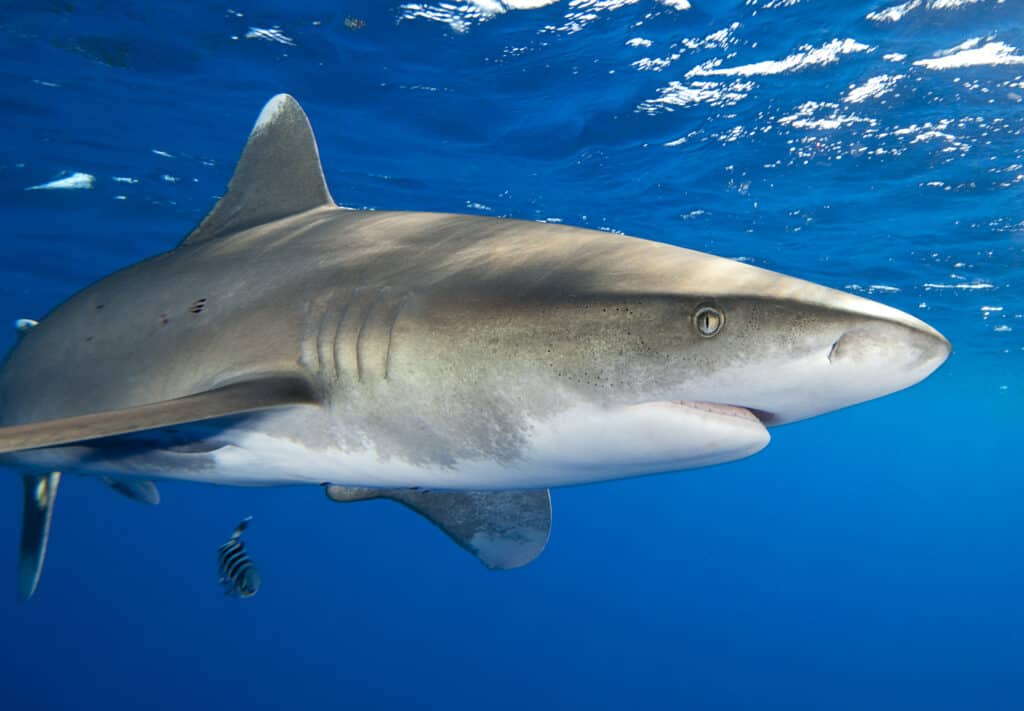
The oceanic whitetip shark has white tips on its fins.
©A Cotton Photo/Shutterstock.com
In the waters encircling Puerto Rico, you might cross paths with another kind of shark known as the oceanic whitetip shark. Recognizable by their white-tipped dorsal, pectoral, and tail fins, these sharks boast a sturdy build. Their dorsal fin is gently rounded, and their pectoral fins take on an elongated, paddle-like form. Generally, these sharks attain lengths of up to 13 feet and frequent warm, tropical, and subtropical waters spanning the globe. They prefer the open ocean, venturing far from the coastline.
When it comes to cuisine, they’re not overly selective. Fish and squid make up the bulk of their diet, yet they’re also known to partake in larger marine creatures, birds, and even, unfortunately, garbage.
In terms of aggression, oceanic whitetips are known to be among the more aggressive sharks in the waters near Puerto Rico. Their broad diet and willingness to eat almost anything make them a species to be cautious around.
9. Bull Shark
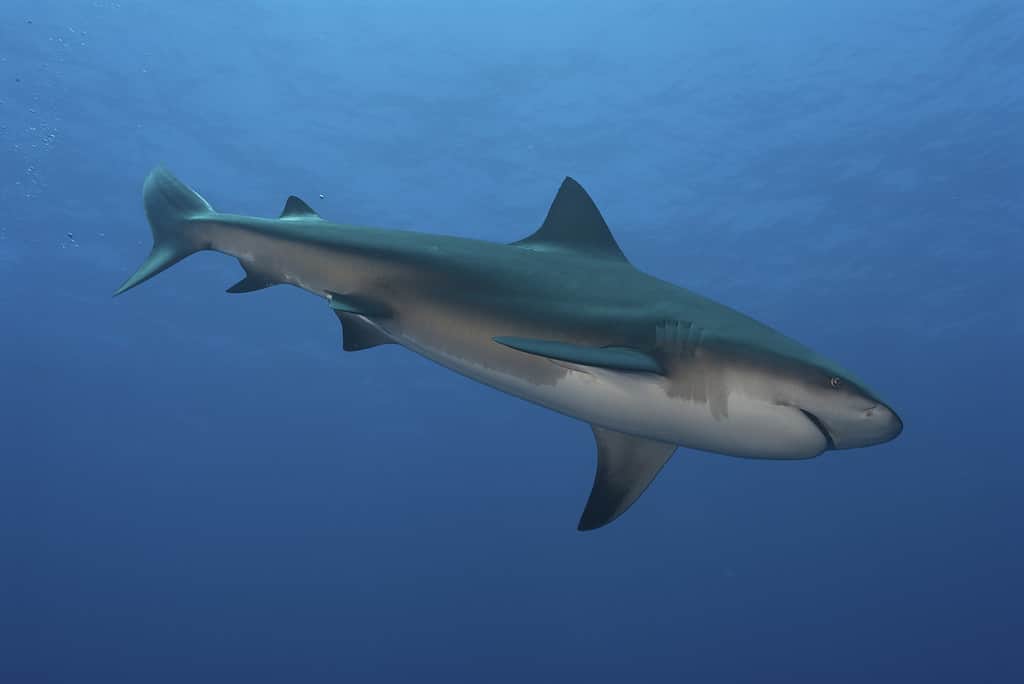
Bull sharks can also swim in freshwater.
©iStock.com/FionaAyerst
If you happen to be navigating the waters near Puerto Rico, you might spot another notable presence: bull sharks. This particular species is renowned for its aggressive behavior. Characterized by a robust physique and a rounded snout, these sharks have a sizable and pointed first dorsal fin, complemented by a noticeably smaller second fin. Their distinction lies in their adaptability to freshwater, which sets them apart from most other sharks. This versatility allows them to inhabit not only oceans but also rivers and lakes.
Typically spanning from 7 to nearly 12 feet in length, females generally outsize their male counterparts. These sharks don’t limit their presence to any specific region and can be found along coastlines spanning the globe.
While fish dominate their menu, their dietary choices also encompass dolphins, sea turtles, and even their fellow sharks. They hunt both during daylight and after sunset.
Though they generally keep to themselves, bull sharks can become highly aggressive if they feel their territory is being invaded or threatened. Encounters with humans can result in serious or even fatal injuries!
10. Great Hammerhead Shark
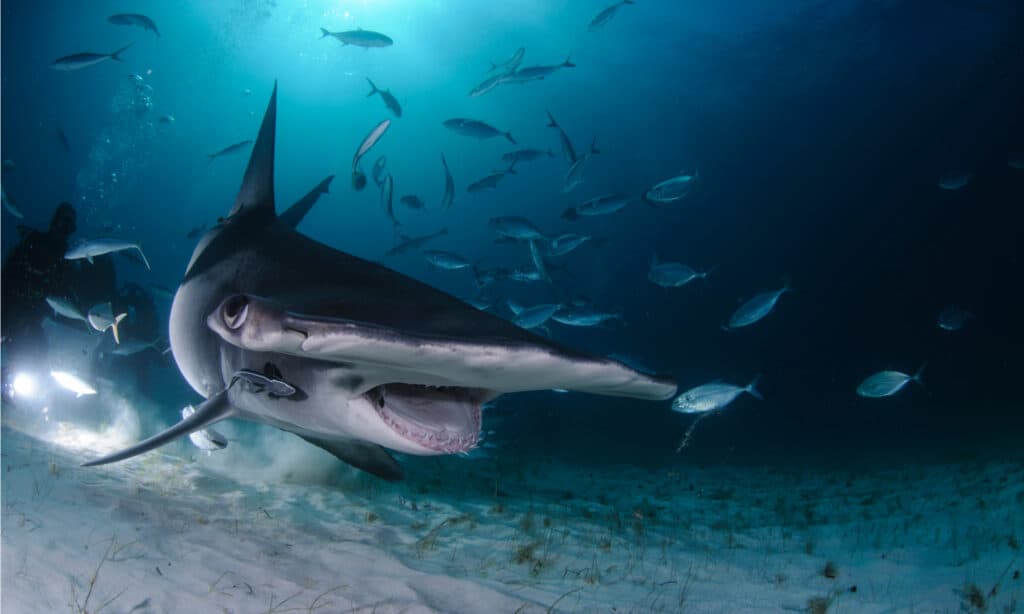
If you’re lucky, you might find a great
hammerhead shark
during a dive in Puerto Rico.
©Martin Voeller/Shutterstock.com
In the vicinity of Puerto Rico’s waters, you could potentially come across the majestic great hammerhead shark, a species that claims the title of the largest in its category. They stand out with their notably expansive dorsal fins, the distinctive form of their hammer-shaped heads, and their serrated teeth.
These sharks usually measure between 12 and 18 feet, making them quite formidable. Though they roam all over the world’s oceans, they prefer to stick close to coastlines and are often seen in shallow waters or lagoons.
When it comes to diet, they love hunting for food on the ocean floor. Stingrays, octopuses, squids, and even other smaller sharks are some of their favorite meals.
While their size might seem intimidating, these sharks aren’t particularly aggressive toward humans. However, they are curious creatures and might approach divers. Unfortunately, they’re heavily targeted for their fins, which are a prized ingredient in shark fin soup, a delicacy in China.
Other Shark Species Found In Puerto Rico
Besides the 10 sharks highlighted above, you can see a great variety of other sharks off Puerto Rico’s beaches. Here are other shark species you may encounter:
- Megamouth Shark
- Blue Shark
- Sevengill Shark
- Caribbean Sharpnose Shark
- Spinner Shark
- Thresher Shark
- Blacknose Shark
- Kitefin Shark
- Basking Shark
- Dusky Smooth-hound Shark
- Shortfin Mako Shark
- Lantern Shark
- Finetooth Shark
- Lemon Shark
- Smoothhound Shark
- Gulper Shark
- Galapagos shark
- Bignose Shark
- Scalloped Hammerhead Sharks
- Catsharks
- Cuban Dogfish
- Great White Shark
- Bigeye Thresher Shark
- Smalltail Shark
Where to Spot Sharks in Puerto Rico
You’ll find a wide variety of shark types in Puerto Rico, some potentially dangerous. Here are some hotspots to catch a glimpse!
Bioluminescent Bay is known for small sharks like the blacktip and lemon varieties. Rather than a hunting zone, this bay acts more like a nursery due to its warm, shallow water and mangrove shelters.
Adult sharks often lay their eggs here and move on, so any sharks you spot here are likely to be young. Swimming isn’t allowed in this special bay, mainly because conservation measures are in place to protect the unique ecosystem and shark population.
If you’re keen on swimming alongside sharks, however, consider Cayo Lobito and Mona Island. These locations boast large numbers of nurse sharks. Coral reefs near Vieques also draw in Caribbean reef sharks.
Another place to note is the famous Black Wall dive off La Parguera’s coast, where depths reach beyond 1,500 feet. This deep environment is perfect for some shark species.
In Puerto Rico, sharks have diverse habitats. Some favor the warm shallows near shores and river outlets, others lean towards coral reefs due to abundant food sources, and some can be spotted while deep-sea fishing.
Shark Attacks in Puerto Rico
The risk of a shark encounter in Puerto Rico, as well as globally, is exceptionally low – despite what many may think. Most types of sharks are not a threat to people.
Records show only 11 verified shark incidents in Puerto Rico since the 18th century. The most recent took place over a decade ago in 2011 near Vieques, occurring at night and resulting in no loss of life. Before this, the prior incident happened way back in 1966.
Generally, Puerto Rico witnesses zero to one shark incident annually. From 1900 until now, fewer than 20 shark incidents have been reported, with 10 being unprovoked and only four ending fatally.
Given the long gaps between incidents, the waters around Puerto Rico are largely considered safe for swimming. However, it’s still a good idea to be cautious of other natural factors like strong currents, high tides, and large waves.
Summary of Sharks Found in Puerto Rico
| Number | Shark | Scientific Name |
|---|---|---|
| 1 | Whale Shark | Rhincodon typus |
| 2 | Antilles Catshark | Galeus antillensis |
| 3 | Silky Shark | Carcharhinus falciformis |
| 4 | Nurse Shark | Ginglymostoma cirratum |
| 5 | Blacktip Reef Shark | Carcharhinus melanopterus |
| 6 | Caribbean Reef Shark | Carcharhinus perezii |
| 7 | Tiger Shark | Galeocerdo cuvier |
| 8 | Oceanic Whitetip Shark | Carcharhinus longimanus |
| 9 | Bull Shark | Carcharhinus leucas |
| 10 | Great Hammerhead Shark | Sphyrna mokarran |
The photo featured at the top of this post is © Aaronejbull87/Shutterstock.com
Thank you for reading! Have some feedback for us? Contact the AZ Animals editorial team.






